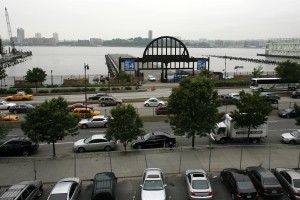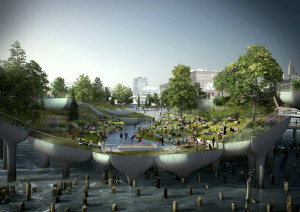

Pier 54 in Manhattan. Image Credit: Pier54.com
Hudson River Park Trust agreed with Barry Diller and Diane von Furstenberg to reconstruct Pier 54 with a larger footprint and with performance spaces that could charge market fees. Pier 54 is a part of the Hudson River Park and is located on West Street and West 13th Street, Manhattan. The pier was built in 1906 for the Cunard Steamship Company, became deteriorated, and was partially dismantled by the Hudson River Park in 2013. The Park proposed to construct a new pier with funds provided by Barry Diller and Diane von Furstenberg. The new pier would be square rather than rectangular, have elevations that ranged from eight feet to approximately 62 feet, be larger in area than the old Pier 54, and have three enclosed performance areas. It would also have landscaped areas, paved walking paths, and seating for both active and passive uses. Under the agreement with Diller and von Furstenberg, the Park would have 51 percent of the performances at the performance areas be free, but 49 per cent could have fees at market rates. The reconstructed pier would be designated Pier 55, constructed north but slightly overlapping a portion of the historic footprint of Pier 54. Petitioners describe the planned location of Pier 55 as a “never-before disturbed stretch of the Hudson River.”
The City Club of New York and individuals sued the Park. The plaintiffs alleged that the proposed construction violated the public trust doctrine because the proposed new pier lacked legislative approval; violated the State environmental laws because the Park failed to produce a full environmental impact statement; and violated the Hudson River Park Act because the proposed uses and design exceeded the Park’s authority.
Manhattan Supreme Court Justice Joan B. Lobis rejected the plaintiffs’ claims and dismissed the complaint. Judge Lobis ruled that the public trust doctrine did not apply because the land belonged to New York State and the doctrine only applies to lands held by local governments, not State-owned lands. Even were the doctrine to apply, the proposal would not be in violation because the new Pier 55 is to be used for public performances, strolling, sitting, and enjoying nature and wildlife.
With respect to the environmental impact, Judge Lobis noted that the Park had prepared an environmental assessment which concluded that the proposal would not have any adverse impacts on the environment, and had issued a negative declaration. She reviewed the assessment in detail and found it sufficient to support the negative declaration.
Finally, with respect to the Hudson River Park Act, Judge Lobis ruled that the Act as amended allowed the new pier to be constructed outside the historic footprint of the old pier and that the uses were within the Park’s authority to sponsor.
City Club of New York v. Hudson River Park Trust, 101068/2015, NYLJ 1202754588720, at *1 (Sup., NY, Decided April 4, 2016)
By: Stephen Caracappa (Stephen is a student at New York Law School, Class of 2018).

